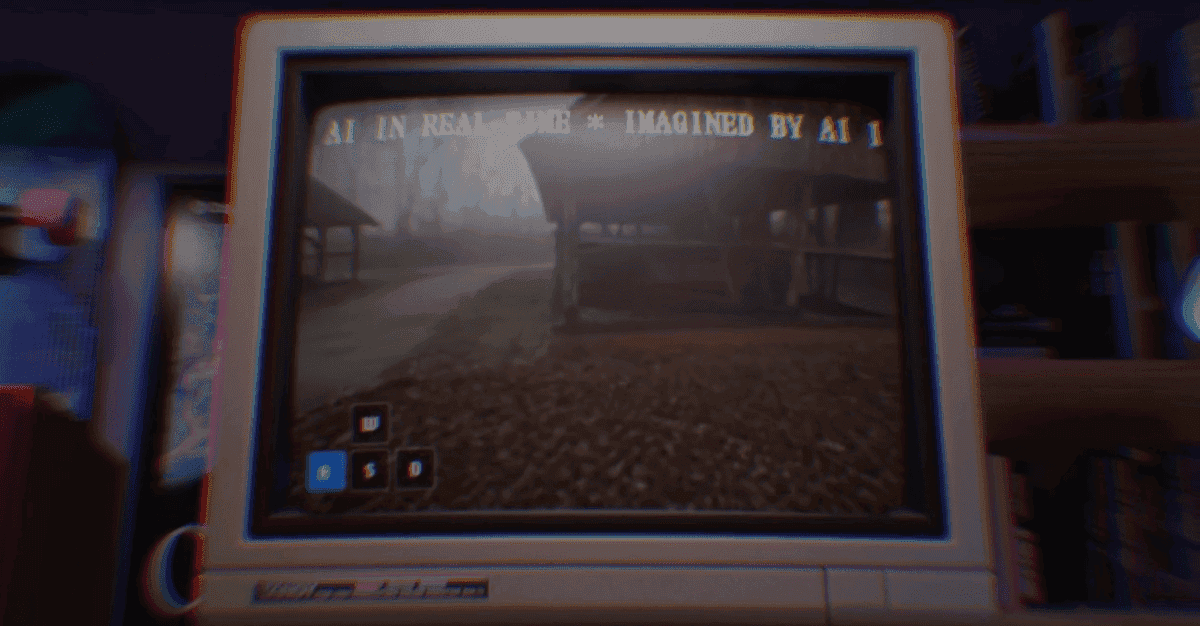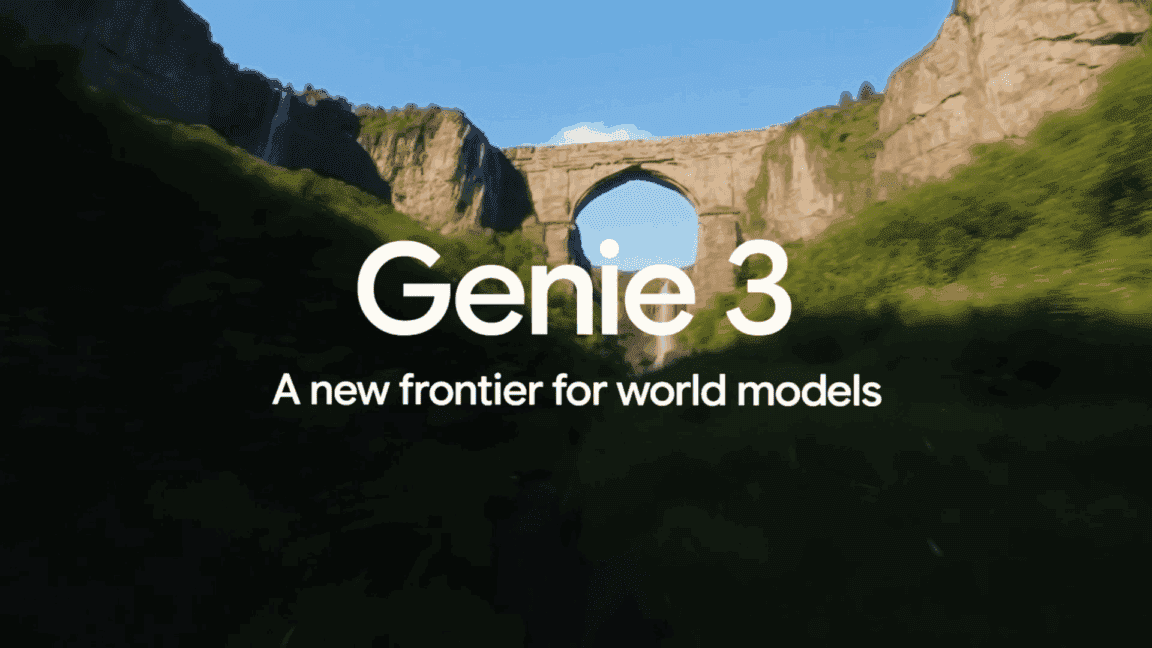Odyssey Unveils Groundbreaking AI-Generated Interactive Video Worlds
6 Sources
6 Sources
[1]
Odyssey's new AI model streams 3D interactive worlds | TechCrunch
Available on the web in an "early demo," the model generates and streams video frames every 40 milliseconds. Via basic controls, viewers can explore areas within a video, similar to a 3D-rendered video game. "Given the current state of the world, an incoming action, and a history of states and actions, the model attempts to predict the next state of the world," explains Odyssey in a blog post. "Powering this is a new world model, demonstrating capabilities like generating pixels that feel realistic, maintaining spatial consistency, learning actions from video, and outputting coherent video streams for 5 minutes or more." A number of startups and big tech companies are chasing after world models, including DeepMind, influential AI researcher Fei-Fei Lee's World Labs, Microsoft, and Decart. They believe that world models could one day be used to create interactive media, such as games and movies, and run realistic simulations like training environments for robots. But creatives have mixed feelings about the tech. A recent Wired investigation found that game studios like Activision Blizzard, which has laid off scores of workers, are using AI to cut corners and combat attrition. And a 2024 study commissioned by the Animation Guild, a union representing Hollywood animators and cartoonists, estimated that over 100,000 U.S.-based film, television, and animation jobs will be disrupted by AI in the coming months. For its part, Odyssey is pledging to collaborate with creative professionals -- not replace them. "Interactive video [...] opens the door to entirely new forms of entertainment, where stories can be generated and explored on demand, free from the constraints and costs of traditional production," writes the company in its blog post. "Over time, we believe everything that is video today -- entertainment, ads, education, training, travel, and more -- will evolve into interactive video, all powered by Odyssey." Odyssey's demo is a bit rough around the edges, which the company acknowledges in its post. The environments the model generates are blurry and distorted, and unstable in the sense that their layouts don't always remain the same. Walk forward in one direction for a while or turn around, and the surroundings might suddenly look different. But the company's promising to rapidly improve upon the model, which can currently stream video at up to 30 frames per second from clusters of Nvidia H100 GPUs at the cost of $1-$2 per "user-hour." "Looking ahead, we're researching richer world representations that capture dynamics far more faithfully, while increasing temporal stability and persistent state," writes Odyssey in its post. "In parallel, we're expanding the action space from motion to world interaction, learning open actions from large-scale video." Odyssey is taking a different approach than many AI labs in the world modeling space. It designed a 360-degree, backpack-mounted camera system to capture real-world landscapes, which Odyssey thinks can serve as a basis for higher-quality models than models trained solely on publicly available data. To date, Odyssey has raised $27 million from investors including EQT Ventures, GV, and Air Street Capital. Ed Catmull, one of the co-founders of Pixar and former president of Walt Disney Animation Studios, is on the startup's board of directors. Last December, Odyssey said it was working on software that allows creators to load scenes generated by its models into tools such as Unreal Engine, Blender, and Adobe After Effects so that they can be hand-edited.
[2]
You can now try interactive AI worlds backed by Pixar's cofounder
Jay Peters is a news editor covering technology, gaming, and more. He joined The Verge in 2019 after nearly two years at Techmeme. AI companies have recently been experimenting with interactive, AI-generated worlds. There's an AI-generated version of Quake. An AI-generated Minecraft. Google DeepMind is also building a team to develop models that "simulate the world." Now, an AI startup backed by Pixar cofounder Edwin Catmull is trying to put its own spin on the idea -- something it calls "interactive video," which it's letting people experience as part of a research preview that's available today. The startup, called Odyssey, describes interactive video on its website as "video you can both watch and interact with, imagined entirely by AI in real-time." The idea is that you can engage with the video in some way -- think a first-person video game but in environments that actually look like the real world instead of one made of polygons. Odyssey hypes it up to be an "early version of the Holodeck," though it acknowledges that "the experience today feels like exploring a glitchy dream -- raw, unstable, but undeniably new." In motion, Odyssey's interactive videos feel like walking through a blurry version of Google Street View. You can walk around the startup's real-time generated worlds using the WASD keys as though it were a game. There are a handful of different worlds you can switch between, like a wooded area with a cabin, a shopping mall, and a parking lot in front of a large building. They're a little different each time, since the system is regenerating what's in your vision each time. But the picture quality is generally pretty fuzzy. For now, you only have two and a half minutes to explore the preview before it stops, but you can reload and hop back in if you'd like. Odyssey says it's using clusters of H100 GPUs in the US and Europe to generate the interactive videos. "Using that input and frame history, the model then generates what it thinks the next frame should be, streaming it back to you in real-time," the company writes on its website, adding that process can happen in "as little as" 40 milliseconds. The current preview isn't going to replace Fortnite anytime soon. Objects only sometimes have collision; in one instance, I was stopped by a fence, but when I tried to walk through a large house, I clipped right through it. In another run, I walked down some stairs only to watch the doorway I was heading toward turn into a brick wall. The preview also acts strangely when you're standing still; I did one full instance where I didn't touch the controls at all, and the model slowly kept turning me left and inched me closer to a wall. In an interview with The Verge, Catmull, who sits on Odyssey's board, couldn't give me a specific answer for when the image quality might get better. But he says that Odyssey is on "the leading edge" of the work that's being done and that "they participate in this broader community, so the information about how to do this keeps improving." He acknowledges that the images are still noisy, but he says that the bulk of the noise, like textures on a building, are "exactly the kind of thing that applying neural network filters to" is meant to solve. It's not a great video game, despite how entertaining the quirks and issues can be. And I don't think this is going to replace movies for a while, either; the way the world morphs and changes in unexpected ways is just too distracting, and I think knowing that what you're watching won't melt in front of you is a key part of a good film. It's not even a good merging of the two mediums -- yet. While messing around with the preview, you can see that there may be something interesting here. With the speed at which AI tools are evolving, it's not too hard to imagine a version of this that doesn't have quite so many issues. But it's no Holodeck yet, and there's quite a ways to go if AI video is going to get there.
[3]
This interactive AI video generator feels like walking into a video game - how to try it
You can try Odyssey's interactive video generator for free, GPUs permitting. With dozens of image generators on the market that can produce hyper-realistic pictures from text prompts, many developers have started tackling a new challenge: video generation. AI lab Odyssey has launched a video generator that unlocks a new kind of interactive experience. Also: Hume's new EVI 3 model lets you customize AI voices - how to try it On Wednesday, Odyssey launched a research preview of its first interactive video experience, which generates video entirely by AI in real time. Viewing and navigating this interactive video is similar to walking through a video game, using your keyboard, controller, and eventually audio. Odyssey described this interactive video as a "new medium of storytelling" that opens the door to fresh forms of entertainment with the advent of on-demand video. The company claimed this medium will transform every instance of video content as we know it today. Specifically, the model generates new frames every 40ms. Also: How to try Veo 3, Google's AI video generator that's going viral on the internet Powering this experience is a real-time world model, which differs from a traditional video model. A world model generates the next video frame by combining the current state, recent history, and the latest actions. The world model completes this process one step at a time, updating as new actions come in. This autoregressive approach enables real-time interaction and reactivity. A video model, by comparison, generates the full experience in one go, making interactivity impossible. There are some instability issues associated with the world model, so the research preview uses a narrow distribution model instead, which was pre-trained broadly on the world and fine-tuned on more specific video data from a smaller set of places. It is worth noting that the experience is not perfect. Odyssey describes the experience as "exploring a glitchy dream -- raw, unstable, but undeniably new." After putting it to the test myself, I can say the description is fitting. The company aims to create hyper-realistic interactive worlds in the future. Odyssey also previewed its next-generation world model, which appeared to be an improvement over the current version. Also: Google Flow is a new AI video generator meant for filmmakers - how to try it today In the 24 hours following its launch, 85,000 streams of interactive video were generated globally, which Odyssey said is equivalent to 250 million video frames. You can try the experience for free. To try the generator, visit the Odyssey world experience site. You don't even need an account to get started. Just click on what looks like a power button, and then navigate the scene you are dropped into using either the buttons on the screen or your keyboard. You can also click through the "world channel" dial to be transported to different scenes or "worlds". You have two minutes, with 30 seconds per round, and then you can restart the experience. The experience is a bit eerie as you navigate these desolate environments, and your POV is as if you were walking through them. As mentioned above, the experience is also a bit fuzzy, so it almost resembles what you would experience if you were walking in an upside-down reality in the TV show Stranger Things. While it may not provide a super-realistic experience, it is noteworthy how the technology can simulate the experience of navigating a world in a video game, with the advantage of being in real-time. To learn more about how the model works, future use cases, potential costs, and more, visit the research preview blog post.
[4]
This Dreamlike Video Generator Makes Interactive AI Feel Like a Lo-Fi Acid Trip
We talk a lot about AI hallucinations nowadaysâ€"and for good reason. "Hallucinations" is basically AI-speak for "making sh*t up," and most of the timeâ€"like in the case of web search, which relies on surfacing real, useful informationâ€"that's a Very Bad Thing. I don't think I'm alone when I say AI shouldn't be recommending that we put glue on our pizza, even if we know enough not to actually do that. But hallucinating doesn't always have to be bad. Sometimes, just like in real life, it can be a heck of a lot of fun, and Odyssey, a new company trying to pioneer interactive AI video, is making a pretty solid case for the fun side of things. Don't take my word for itâ€"see for yourself. Odyssey is exactly as the company describesâ€"a web-based world where you can stream AI-generated video. Unlike other video generators like Google's Veo 3, which requires using a text prompt to create a video that you can only watch, Odyssey generates a whole world that you can actually explore using your keyboard. If you're reading this and thinking, "Isn't that Minecraft or any number of world-generating games out there?" apparently there actually is a difference, according to Odyssey. There is no game engineâ€"all of the worlds are being generated in real time as you explore them. Per Odyssey, it "streams video frames every 40ms" for a continuously generated experience. As a follower of video generation and AI, I naturally jumped straight into trying out Odyssey for myself, and the "game," if you can call it that, is weird in the best way possible. For now, everything in Odyssey is very lo-fi, which for most interactive apps (AI-generated or otherwise) would be a bad thing, but in this case, it kind of works. It leans into the necessity for a low frame rate to deliver hazy, almost dreamlike worlds. It's like if you took 3D imagery from Google Maps, funneled it into a VCR, and then played it back after freebasing some experimental new research chemical made from thermal paste. (Disclaimer: Please don't try that at home, folks.) The whole thing, as you might imagine, is pretty buggy, too. Environments render and sometimes disappear, making the whole thing even more hallucinatory than it already is. Using your keyboard WASD-style to explore the worlds is decidedly a slow, plodding experience, but I can't say I'm particularly mad about that. Everything in Odyssey feels experimental to an extent, and the fuzzy nature of scanning through worlds with an almost radio-like tuner comes off as more of an aesthetic choice, even if it's actually a technical necessity. That doesn't mean the creators of Odysseyâ€"backed by Pixar cofounder Edwin Catmull, as noted by The Vergeâ€"aren't looking to up the visual ante. A next-gen version of Odyssey is already in the pipeline, though it's hard to say when that will materialize and how much of a visual improvement it will be For now, the experience is exactly what it needs to beâ€"it's interesting and glitchy. I'm sure things are bound to get more complex and maybe more convoluted as they progress, but these are the early stages we can actually appreciate without having to overthink it. I know AI-generated video is in a strange state right now, but if you've got the time, I recommend taking a weird, disjointed stroll through Odyssey. It might just be the only AI video experience that doesn't fill you with dread right now.
[5]
I tried exploring a real-time generated AI world, and it was like walking through the uncanny valley
Google Maps Street View and similar tools allow you to virtually navigate real-world locations from the ground, even if you can't interact with what you see. A new tool from AI startup Odyssey offers an experience in AI-generated locations that you can interact with, and it's produced in almost real-time. Odyssey calls it "interactive video," an AI-powered world that reacts to your actions. You can visit the AI-made spaces, using your keyboard to explore a range of forests, stores, parking lots, and buildings that shift as you move. The system guesses and shows new parts of the video so fast that it feels like a blend of a video game and a weird dream. The interactive video utilizes what Odyssey calls a "world model," which simulates a visual environment in response to your actions. Unlike a traditional video game, where every texture, collision, and scenario is crafted ahead of time, Odyssey's AI comes up with what you see on the fly. Every step you take prompts the AI to render a new frame, one that tries to make sense of your motion in context. It's essentially a video that responds like a video game. Behind the scenes, the system generates a new video frame roughly every 40 milliseconds. That's fast enough to make the experience feel fluid, even if it occasionally stutters or lags. The goal isn't photorealism yet. Odyssey is more interested in responsiveness. The idea is to have AI generate the story of your exploration as you move around, rather than relying on pre-written narratives. You can see a clip of some of my exploration above. The low-resolution visuals combined with the ambient soundtrack made it seem like I was in a low-budget avant-garde film, or possibly about to be murdered and my case given to some quirky but brilliant European detective. The textures are soft and slightly blurry. Walls sometimes ripple. I even walked on water at one point. But it is real, in the way an early 90s video game's graphics are realistic. It's like the terrible videos early cellphones shot, or how games like Doom and Quake look to my eyes after 30 years. Then again, Doom once looked like the future, and I took plenty of terrible videos on a flip phone just because I could and because I didn't care that each pixel was the size of a pea. Odyssey is still glitchy, but it is impressive, at least enough to prompt more than a few people to respond on social media, accusing the company of lying about what they had created. Odyssey is well aware that they still have work to do. The company itself describes the experience as "a glitchy dream." Or maybe the comparison should be a live improv show where you get called up on stage, as opposed to taking part in a polished and rehearsed play. There are still many technical, ethical, and basic functionality questions to be answered, but assuming they are addressed to people's satisfaction, you can extrapolate a lot of interesting uses for Odyssey. With enough training data and fine-tuning, you could produce personalized experiences that adapt to your interests and style. Imagine exploring that previously mentioned murder mystery where the characters react to your suspicions. Or a history lesson where Julius Caesar comments on your terrible toga-tying technique. Then again, it could also mean advertisements where the product placement literally walks over to you to strike up a chat. Wobbly visuals, inconsistent physics, and a lack of story logic are significant hurdles, but this could be the shape of all kinds of entertainment.
[6]
Odyssey's AI literally turns your screen into a playable explorable universe
Odyssey, a startup founded by Oliver Cameron and Jeff Hawke, has developed an AI model allowing users to interact with streaming video. Its early web demo generates and streams video frames every 40 milliseconds, letting viewers explore areas within these videos. According to the startup's blog post, the model predicts the next state of the world based on the current state, incoming action, and a history of states and actions. Odyssey states this is powered by a new world model capable of generating pixels that feel realistic, maintaining spatial consistency, learning actions from video, and outputting coherent video streams for 5 minutes or more. Several startups and Big Tech companies are also pursuing world models, including DeepMind, Fei-Fei Li's World Labs, Microsoft, and Decart. These entities envision that such models could be used to create interactive media and run realistic simulations. Video: Odyssey Creative professionals have expressed mixed feelings about this technology. A Wired investigation found that game studios, such as Activision Blizzard, are using AI to cut costs. Furthermore, a 2024 study commissioned by the Animation Guild estimated that AI could disrupt over 100,000 U.S.-based film, television, and animation jobs. In response, Odyssey states it is pledging to collaborate with creative professionals rather than replace them. "Interactive video opens the door to entirely new forms of entertainment, where stories can be generated and explored on demand, free from the constraints and costs of traditional production," the company writes in its blog post. It believes that video across entertainment, ads, education, training, and travel could evolve into interactive video. The company acknowledges that its demo is still under development, noting that the environments its model generates can be blurry, distorted, and unstable. The layouts do not always remain consistent as the viewer moves through the environment. You can now speak to Claude AI as its voice mode rolls out Odyssey is promising to improve the model, which currently streams video at up to 30 frames per second from clusters of Nvidia H100 GPUs at a cost of $1 to $2 per "user-hour." The startup says it is researching richer world representations that capture dynamics more faithfully while increasing temporal stability and persistent state. It is also expanding the action space from motion to world interaction, learning open actions from large-scale video. To capture real-world landscapes, Odyssey designed a 360-degree, backpack-mounted camera system. The team believes this method can serve as a basis for higher-quality models compared to those trained solely on publicly available data. To date, the company has raised $27 million from investors, including EQT Ventures, GV, and Air Street Capital. Ed Catmull, a co-founder of Pixar and former president of Walt Disney Animation Studios, is on the startup's board of directors. Last December, Odyssey announced it was developing software to allow creators to load scenes generated by its models into tools such as Unreal Engine, Blender, and Adobe After Effects for manual editing.
Share
Share
Copy Link
Odyssey, an AI startup, has launched a research preview of its interactive video technology, allowing users to explore AI-generated 3D worlds in real-time. The technology, while still in early stages, promises to revolutionize entertainment and storytelling.
Odyssey Introduces AI-Generated Interactive Video Worlds
Odyssey, an AI startup backed by Pixar co-founder Edwin Catmull, has unveiled a groundbreaking technology that generates interactive 3D worlds in real-time. The company has launched a research preview of its "interactive video" platform, allowing users to explore AI-generated environments using basic controls
1
.
Source: Dataconomy
How It Works
The technology utilizes a "world model" that generates and streams video frames every 40 milliseconds, creating a responsive environment that users can navigate using keyboard controls. Unlike traditional video games, Odyssey's system doesn't rely on pre-rendered assets but instead generates the entire world on the fly
2
.Current Capabilities and Limitations
In its current state, the experience is described as "exploring a glitchy dream"
3
. Users can explore various environments such as forests, shopping malls, and parking lots. However, the visuals are blurry and unstable, with objects and layouts sometimes changing unexpectedly1
.
Source: The Verge
The system runs on clusters of Nvidia H100 GPUs, costing between $1-$2 per "user-hour" to operate. Despite its limitations, the technology has garnered significant interest, with 85,000 streams generated globally within 24 hours of its launch
3
.Future Potential and Improvements
Odyssey is actively working on improving the technology, aiming for richer world representations, increased temporal stability, and expanded interaction capabilities
1
. The company envisions this technology evolving into new forms of entertainment, education, and advertising4
.Related Stories
Industry Impact and Concerns
The development of world models like Odyssey's is being pursued by several tech giants and startups, including DeepMind, Microsoft, and Decart. These models could potentially revolutionize interactive media creation and simulations for robot training
1
.However, the technology has raised concerns in the creative industry. A 2024 study commissioned by the Animation Guild estimated that over 100,000 U.S.-based film, television, and animation jobs could be disrupted by AI in the near future
1
.User Experience and Public Reception

Source: ZDNet
Early users have described the experience as surreal and reminiscent of early video games or low-budget avant-garde films
5
. While the current version is far from perfect, many see the potential for future applications in personalized storytelling, education, and even advertising5
.As Odyssey continues to refine its technology, the company aims to collaborate with creative professionals rather than replace them, potentially opening up new avenues for interactive storytelling and entertainment
1
.References
Summarized by
Navi
Related Stories
Odyssey Unveils AI-Powered Explorer Tool for Generating Photorealistic 3D Worlds
19 Dec 2024•Technology

World Labs Unveils Groundbreaking AI System for Generating Interactive 3D Environments from Single Images
03 Dec 2024•Technology

Midjourney Launches AI Video Generation Model V1, Entering Competitive AI Video Market
19 Jun 2025•Technology

Recent Highlights
1
OpenAI releases GPT-5.2 AI model after code red memo targets Google's Gemini 3 threat
Technology

2
Disney invests $1 billion in OpenAI, licenses 200+ characters for Sora video generator
Technology

3
Disney accuses Google of massive copyright infringement through AI-generated character images
Policy and Regulation





